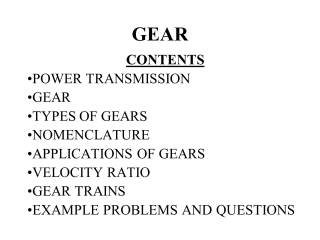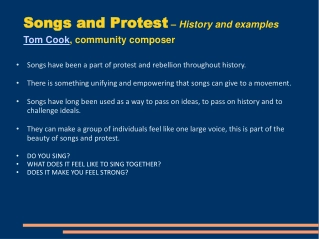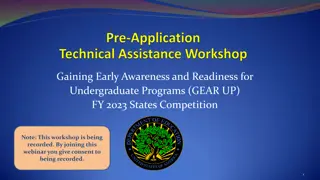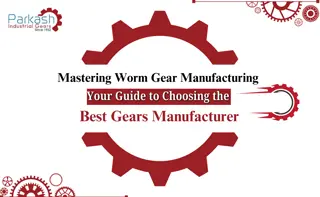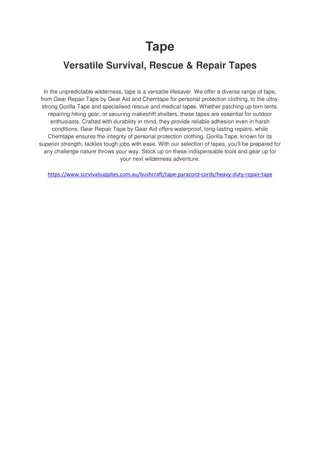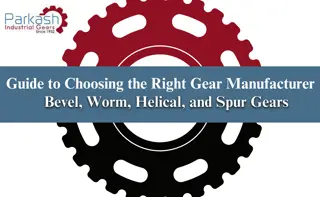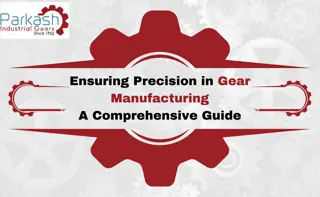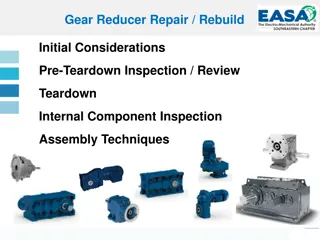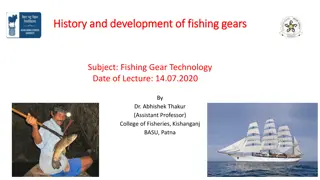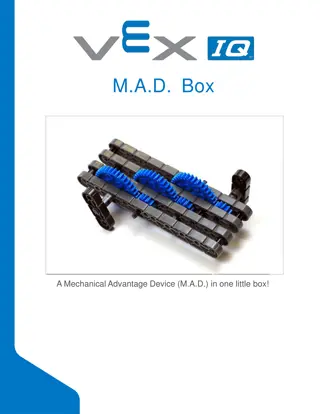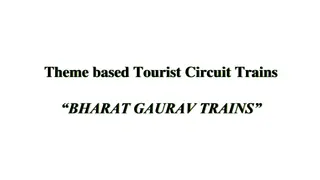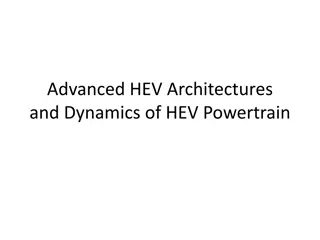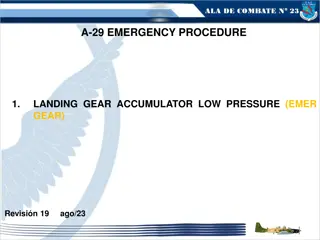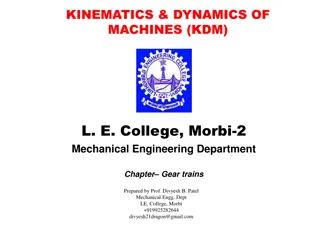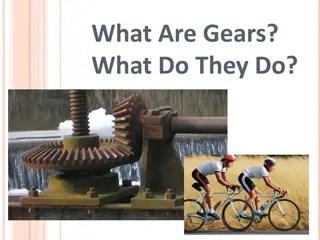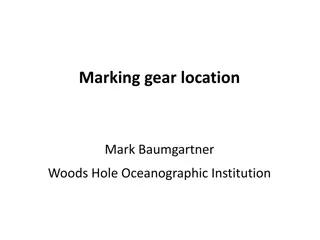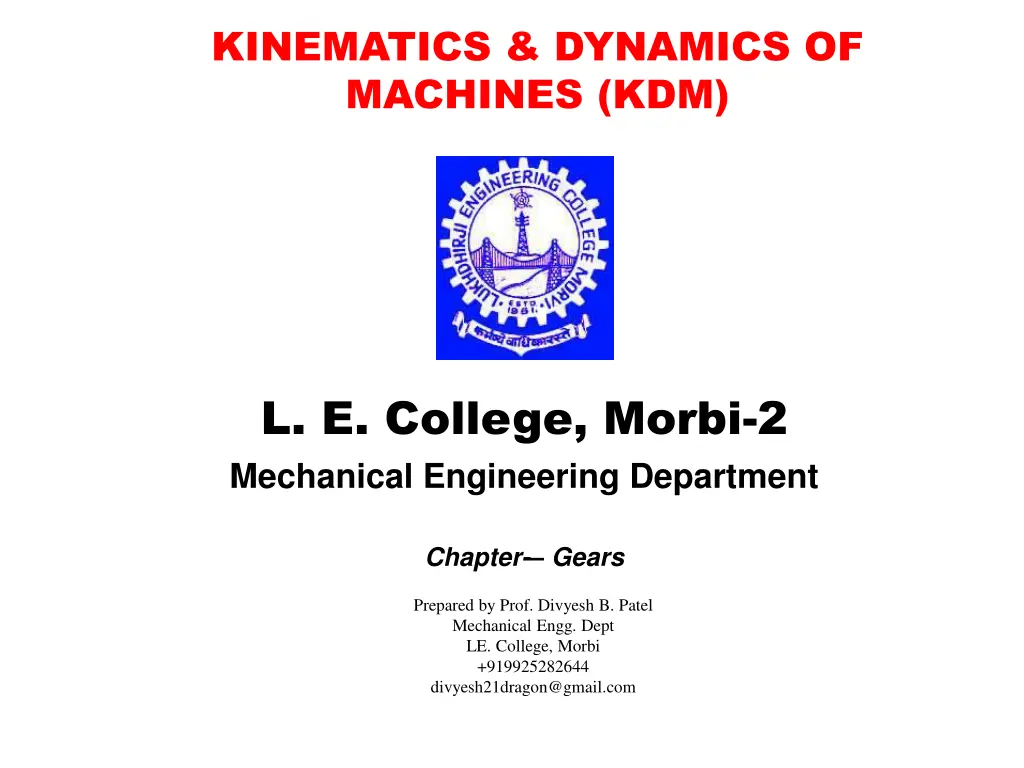
Gears in Kinematics and Dynamics of Machines
Discover the in-depth study of gears in the field of Kinematics and Dynamics of Machines, prepared by Prof. Divyesh B. Patel from L. E. College, Morbi. Explore topics like the law of gearing, velocity of sliding, cycloid, epicycloid, hypocycloid, and cycloidal motion.
Download Presentation

Please find below an Image/Link to download the presentation.
The content on the website is provided AS IS for your information and personal use only. It may not be sold, licensed, or shared on other websites without obtaining consent from the author. If you encounter any issues during the download, it is possible that the publisher has removed the file from their server.
You are allowed to download the files provided on this website for personal or commercial use, subject to the condition that they are used lawfully. All files are the property of their respective owners.
The content on the website is provided AS IS for your information and personal use only. It may not be sold, licensed, or shared on other websites without obtaining consent from the author.
E N D
Presentation Transcript
KINEMATICS & DYNAMICS OF MACHINES (KDM) L. E. College, Morbi-2 Mechanical Engineering Department Chapter- Gears Prepared by Prof. Divyesh B. Patel Mechanical Engg. Dept LE. College, Morbi +919925282644 divyesh21dragon@gmail.com
Prepared by Prof. D.B.Patel Mechanical Engg. Dept LE. College, Morbi LAW OF GEARING O2 The common normal at the point of contact between a pair of teeth must always through the pitch point. 2 Wheel-2 pass T Common normal N E P V1*cos =V2* cos Q ( 1*O1Q ) *cos = ( 2*O2Q ) * cos V1 M ( 1*O1Q ) * = ( 2*O2Q ) * C V2 T Wheel-1 D 1 O1
Prepared by Prof. D.B.Patel Mechanical Engg. Dept LE. College, Morbi VELOCITY OF SLIDING OF TEETH The velocity of sliding is the velocity of one tooth relative to its mating tooth along the common tangent at the point of contact. From similar triangles QEC and O1MQ, O2 2 EC ??= ?1 ?1?= ?1 EC = ?1?? Wheel-2 From similar triangles QED and O2 NQ, T ED QN= V2 O2Q= 2 Common normal ED = ?2?? N Let Vs= Velocity of sliding at Q. E P Q Wheel-1 Vs = ED EC = 2QN 1QM V1 M Vs = 2PQ + PN 1MP PQ C V2 Vs = 2+ 1PQ + 2PN 1MP T ?1 2 =?2? ?1?=PN D MP 1 Vs = 2+ 1PQ O1
Prepared by Prof. D.B.Patel Mechanical Engg. Dept LE. College, Morbi CYCLOID p4 4 p3 p5 3 5 p6 C p2 C1 C2 C3 C4 C5 C6 C7 C8 6 2 p1 p7 1 7 p8 P D
Prepared by Prof. D.B.Patel Mechanical Engg. Dept LE. College, Morbi EPI CYCLOID : Generating/ Rolling Circle 5 4 C2 6 3 7 2 1 P r = CP Directing Circle r R 3600 = O
Prepared by Prof. D.B.Patel Mechanical Engg. Dept LE. College, Morbi HYPO CYCLOID P 7 P1 6 P2 1 5 P3 2 4 P4 3 P8 P5 P6 P7 r R 3600 = O OC = R ( Radius of Directing Circle) CP = r (Radius of Generating Circle)
Prepared by Prof. D.B.Patel Mechanical Engg. Dept LE. College, Morbi CYCLOIDAL : Face 5 4 C2 6 3 7 2 h g P1 P 1 f a Flank e b c d O
Prepared by Prof. D.B.Patel Mechanical Engg. Dept LE. College, Morbi Base circle of Wheel O2 Wheel Addandum circles Tooth of wheel Pitch circle of Pinion & Wheel Tooth of Pinion Base circle of Pinion P O1 Pinion
Prepared by Prof. D.B.Patel Mechanical Engg. Dept LE. College, Morbi P2 P3 P1 4 to p P4 4 3 5 2 6 1 7 A 8 7 8P P5 P8 1 2 3 4 5 6 P7 P6 D
Prepared by Prof. D.B.Patel Mechanical Engg. Dept LE. College, Morbi 1 A 8 2 3 7 6 4 5
Prepared by Prof. D.B.Patel Mechanical Engg. Dept LE. College, Morbi Base circle of Wheel O2 Wheel Addendum circles N B Common Tangent of Pitch Circle Pitch circles of Pinion & Wheel Pressure angle B P Q Base circle of Pinion A M A O1 Pinion
Prepared by Prof. D.B.Patel Mechanical Engg. Dept LE. College, Morbi LENGTH OF PATH OF CONTACT Base circle of Wheel RA O2 Wheel Addendum circle of Wheel R Path of recess N Pressure angle Pitch circle of Pinion & Wheel Path of approach L K Base circle of Pinion P M Addendum circle of Pinion r rA= O1L RA= O2K r = O1P R = O2P O1 Pinion rA
O1M =O1P cos = r cos O2N =O2P cos = R cos From right angled triangle O2KN KN = ((O2K)2- (O2N)2)1/2 O2 Wheel KN = { (RA)2- (R2cos2 ) }1/2 PN = O2P sin = R sin Length of the part of the path of contact, or the path of approach RA N KP = KN PN = {(RA)2- (R2cos2 ) }1/2- R sin L From right angled triangle O1ML ML = {(O1L)2- (O1M)2}1/2 ML = {(rA)2- (r2cos2 ) }1/2 K P M MP = O1P sin = r sin rA Length of the part of the path of contact, or the path of recess PL = ML MP = {(rA)2- (r2cos2 ) } 1/2- r sin O1 Pinion Length of the part of contact, KL = LP +PK = {(RA)2- (R2cos2 ) }1/2+{(rA)2- (r2cos2 ) } 1/2 ( R + r) sin
Prepared by Prof. D.B.Patel Mechanical Engg. Dept LE. College, Morbi LENGTH OF ARC OF CONTACT
Prepared by Prof. D.B.Patel Mechanical Engg. Dept LE. College, Morbi LENGTH OF ARC OF CONTACT CO1D = GO1H = O2 Wheel Arc (GH) = r .(1) Arc (CD) = rb = r cos (2) From Eq. (1) and (2) Arc of Recess N L Arc of Approach Arc (GH)/ Arc (CD) = r /rb =r/ r cos G P H K C D M Arc (GH) = Arc (CD) /cos r cos Arc (GH) = Length of path of contact /cos O1 Pinion Arc (GH) = KL/cos
Prepared by Prof. D.B.Patel Mechanical Engg. Dept LE. College, Morbi Contact Ratio (or Number of Pairs of Teeth in Contact) The contact ratio or the number of pairs of teeth in contact is defined as the ratio of the length of the arc of contact to the circular pitch. Mathematically, Contact ratio or number of pairs of teeth in contact = Length of path of contact /Pc The contact ratio is usually a real number and it s value lies between 1 to 2 When contact ratio is 1, it means that only one pair of teeth of two mating gears will occupy the entire arc GPH In case the contact ratio is more than 1, say its valve 1.5. It means that when one pair of teeth of two meshing gear will just entering in to engagement, the preceding pair of teeth is still in contact.
Prepared by Prof. D.B.Patel Mechanical Engg. Dept LE. College, Morbi Interference in Involutes Gears At every instance the portion of the tooth profile which are in contact must be involute so that line of action does not deviate. O2 Wheel If any portion of the tooth profile in contact is not involute, the surfaces in contact will not touch each other tangentially causing the improper transmission of motion and power. In such case, the relative motion between tooth surface will not be proper sliding motion and thus the transmission of motion will be rough. L Under cut N Pressure angle L Mating of two non-conjugate or non involute tooth profiles is known as interference. P K M O1 Pinion
Minimum Number of Teeth on the Pinion in Order to Avoid Interference T = No. of teeth on Wheel From triangle O1NP, RA O2 Wheel (O 1N )2= (O1P ) 2+(PN )2-2 (O1P) (PN) cos O1PN (O 1N )2= r2+(Rsin )2- 2 (r) (Rsin ) cos(90 + ) cos(90 + ) = -sin R (O 1N )2= r2+R2sin 2+ 2 (r) (R)(sin2 ) N (O 1N )2= r2{1+(R2sin 2)/r2+ 2 (R)(sin2 )/r } (O 1N )2= r2{1+R/r [R/r + 2 ] (sin2 ) } (O 1N ) = r ( {1+R/r [R/r + 2 ] (sin2 ) })1/2 L P K M + 90 m = 2r/t = 2R/T , r = mt/2 , R = mT/2 r (O 1N ) = mt/2 ( {1+T/t [T/t + 2 ] (sin2 ) })1/2 O1 Pinion rA (O 1N ) = mt/2 ( {1+G [T/t + 2 ] (sin2 ) })1/2 t = No. of teeth on Pinion
AP.m = Addendum of the pinion, where APis a fraction by which the standard addendum of one module for the pinion should be multiplied in order to avoid interference. We know that the addendum of the pinion = O1N O1P AP.m = mt/2 ( {1+T/t [T/t + 2 ] (sin ) })1/2- mt/2 O1P = r =mt/2 AP.m = mt/2[ ( {1+T/t [T/t + 2 ] (sin ) })1/2- 1] AP. = t/2[ ( {1+T/t [T/t + 2 ] (sin ) })1/2- 1] t = 2AP /[ ( {1+T/t [T/t + 2 ] (sin ) })1/2- 1] t = 2AP /[ ( {1+G [G + 2 ] (sin ) })1/2- 1] Gear ratio G= T/t If the pinion and wheel have equal teeth, then G = 1. t = 2AP /[ ( {1+3(sin ) })1/2- 1]
Minimum Number of Teeth on the Wheel in Order to Avoid Interference T = No. of teeth on Wheel From triangle O2MP, RA O2 Wheel (O 2M )2= (O2P ) 2+(PM )2-2 (O2P) (PM) cos O2PM (O 2M )2= R2+(r sin )2- 2 (R) (r sin ) cos(90 + ) cos(90 + ) = -sin R (O 2M )2= R2+r2sin2 + 2 (r) (R)(sin2 ) N (O 2M )2= R2{1+(r2sin 2)/R2+ 2 (r)(sin2 )/R } (O 2M )2= R2{1+r/R [r/R + 2 ] (sin2 ) } (O 2M ) = R ( {1+r/R [r/R + 2 ] (sin2 ) } )1/2 L P K M + 90 m = 2r/t = 2R/T , r = mt/2 , R = mT/2 r (O 2M ) = mT/2 ( {1+t/T[t/T+ 2 ] (sin2 ) })1/2 O1 Pinion rA (O 2M ) = mT/2 ( {1+1/G [1/G+ 2 ] (sin2 ) })1/2 t = No. of teeth on Pinion
AW.m = Addendum of the wheel, where AWis a fraction by which the standard addendum of one module for the wheel should be multiplied in order to avoid interference. We know that the addendum of the wheel = O2M O2P AW.m = mT/2 ( {1+t/T[t/T+ 2 ] (sin2 ) })1/2 - mT/2 O2P =R= mT/2 AW.m = mT/2 [( {1+t/T[t/T+ 2 ] (sin2 ) })1/2- 1] AW. = T/2 [( {1+t/T[t/T+ 2 ] (sin2 ) })1/2- 1] T = 2AW / [( {1+t/T[t/T+ 2 ] (sin2 ) })1/2- 1] T = 2AW /[ ({1+1/G [1/G+ 2 ] (sin2 ) })1/2- 1] Gear ratio G= T/t If the pinion and wheel have equal teeth, then G = 1. t = 2AW /[ ( {1+3(sin ) })1/2- 1]

